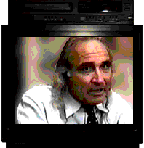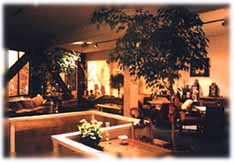


 T his is our library area. We call this the library. It actually tends to be a little bit quieter. We have these nice couches and a big TV over here. People like to relax, watch videos. These gentlemen are from 48 Hours; they're doing something for TV right now.
T his is our library area. We call this the library. It actually tends to be a little bit quieter. We have these nice couches and a big TV over here. People like to relax, watch videos. These gentlemen are from 48 Hours; they're doing something for TV right now.
TOD H. MIKURIYA MD
 "From 1839 to 1938 cannabis was available by prescription and utilized for a
variety of conditions
"From 1839 to 1938 cannabis was available by prescription and utilized for a
variety of conditions  before removal after the passage of the 1937 Marihuana Tax Act
at which time it was an infrequently used sedative and antispasmodic . Since then it
has been legally defined as having no medicinal redeeming virtue [and] having high
potential for abuse by the Controlled Substances Act of 1970 as a Schedule I drug.
"
before removal after the passage of the 1937 Marihuana Tax Act
at which time it was an infrequently used sedative and antispasmodic . Since then it
has been legally defined as having no medicinal redeeming virtue [and] having high
potential for abuse by the Controlled Substances Act of 1970 as a Schedule I drug.
"
LESTER GRINSPOON, MD
JAMES B. BAKALAR, JD
 "Between 1840 and 1900, European and American medical journals published
"Between 1840 and 1900, European and American medical journals published more than 100 articles on the therapeutic use of the drug known then as Cannabis
indica (or Indian hemp) and now as marihuana. It was recommended as an appetite
stimulant, muscle relaxant, analgesic, hypnotic, and anticonvulsant. As
late as 1913
Sir William Osler recommended it as the most satisfactory remedy for migraine."
more than 100 articles on the therapeutic use of the drug known then as Cannabis
indica (or Indian hemp) and now as marihuana. It was recommended as an appetite
stimulant, muscle relaxant, analgesic, hypnotic, and anticonvulsant. As
late as 1913
Sir William Osler recommended it as the most satisfactory remedy for migraine."
JAMES RUTENBERG
 "According to the anecdotal evidence, however, marijuana brings appetites back to
people with
"According to the anecdotal evidence, however, marijuana brings appetites back to
people with  AIDS and cancer whose treatments make them so nauseous they have a
hard time keeping food down; helps people with multiple sclerosis fight the loss
of muscle tone; slows down the degenerative effects of glaucoma; and opens up
air passages in the lungs of asthmatics."
AIDS and cancer whose treatments make them so nauseous they have a
hard time keeping food down; helps people with multiple sclerosis fight the loss
of muscle tone; slows down the degenerative effects of glaucoma; and opens up
air passages in the lungs of asthmatics."

![[ELEVATOR]](lob_door.jpg)
